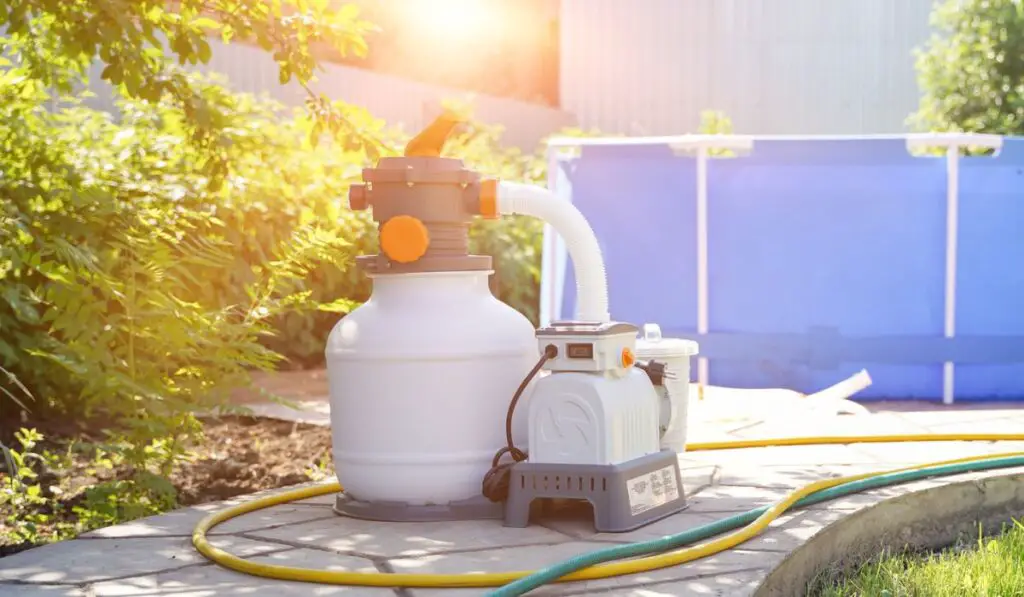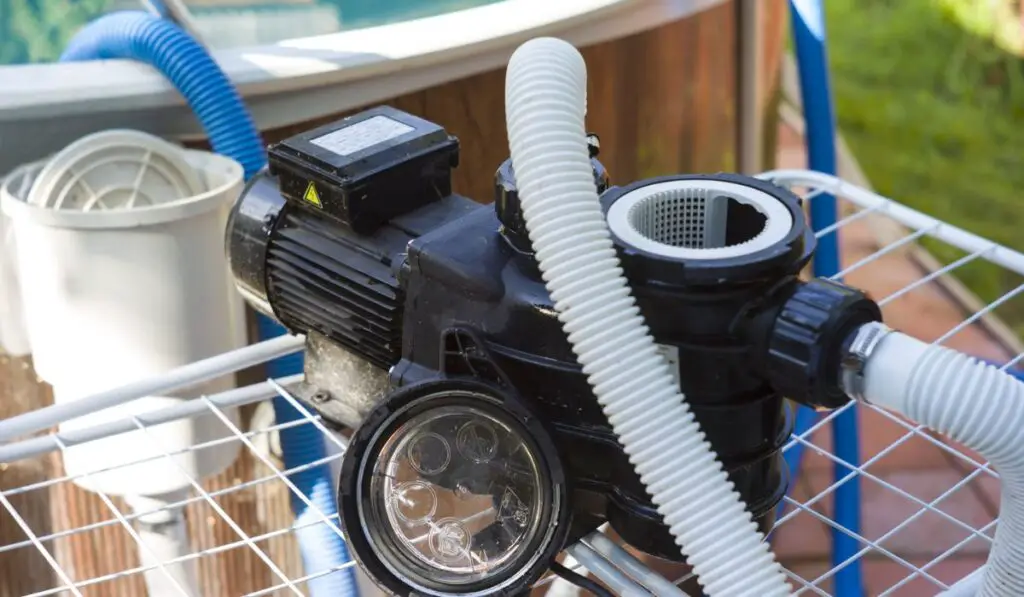The best way to beat the intense summer heat and sticky, humid air is to take a dip in your backyard swimming pool. But if your pool pump stops working, you’ll basically be diving into a grimy swamp instead of the clear, refreshing water you deserve. So, how long do pool pumps last, and how do you know when they need to be replaced?
Pool pumps usually last 8-12 years, but if you’ve missed out on critical pool services, then they’ll stop functioning much earlier. If your pool pump is making a lot of screeching or grinding noises, tripping the electrical breaker, or losing suction, then it might be time for a replacement.
A pool pump is the very heart of a swimming pool. It ensures a constant water flow and pushes the pool water through a filter, chlorinator, or other components that ensure clean, bacteria-free water. Let’s look at whether pool pumps go bad, when you should opt for a replacement, how much it will cost, and whether you can replace the pool pump yourself.
Do Pool Pumps Last Forever?

Pool pumps like this one (example on Amazon) pull water from your swimming pool and push it through the filter, ensuring a clean, consistent water flow. Many, like this Intex model (also on Amazon), come integrated into a sand filtration system.
However, just like any other pool component, they can deteriorate and will eventually cease functioning properly.
As one of the most important parts of your pool, it’s essential to know when the pool pump is on its last legs and might be in need of replacement or repair. Without a working pool pump, your clear, beautiful pool pump will turn into a germ-laden swamp pretty quickly.
How Do You Know When to Replace Your Pool Pump?
It’s pretty easy to identify a faulty pool pump, and you don’t need to disassemble or open up anything to check for the telltale signs. With only a good pair of ears and eyes, you’ll be able to determine when it’s time to replace your pool pump.
Let’s review some of the signs to look for.
Age
An aging pool pump can be a sign of early trouble. If your pump is older than the majority of the cars you see on the road, then it’s a good idea to keep a close eye on your pool motor and pump.
Most pool pumps have an average life of 8 to 12 years. Over time, their components start to wear down and they eventually need to be replaced.
Luckily, pool technology has advanced significantly in the last 10 years. Most modern pool pumps are much more energy-efficient than their predecessors, allowing you to control their variable speeds as needed.
So, if your pool pump is getting old, it’s best to replace it with a newer, variable-speed model. Although the new purchase might seem expensive, it will ultimately help cut down maintenance costs in the long run, and it’s best to take action before your pump stops working without warning.
Noise
Pool pumps are designed to run quietly. They shouldn’t make any unpleasant grinding or screeching noises when you’re trying to unwind and relax.
If your pool pump is making any loud, out-of-character sounds, then it might not be working properly. Grinding or screeching sounds usually indicate a faulty motor. Your motor might also be covered with rust because of unwanted pool water getting in through a leaky shaft seal.
Power Trip
If your pump motor has been overloading the circuit or tripping the electric breaker more and more frequently, then you have a problem.
It’s possible that you’ve simply connected too many appliances to a single circuit. But if you haven’t added any additional devices to the circuit in the past few days and the pump still trips the circuit whenever it turns on, you might have to replace the pump.
This increase in power is usually an indication of a more serious electrical issue. It often means that your pump motor is about to go kaput and you’ll soon need to replace the entire pool pump.
Pump Motor Keeps Turning Off
If your pool pump keeps switching off automatically, it might be because of an overheating motor. Most pumps are designed with a safety feature that forces them to shut down if they reach too high of a temperature — and then it restarts them once they cool down.
It’s important to fix this problem as soon as possible to prevent the pump from breaking down entirely. If you leave the problem unaddressed, the motor will only deteriorate further, ultimately necessitating a pump replacement.
Loss of Suction
Pool pumps suck in water and then pass it through the filtration system to remove germs and debris before pushing it back into your pool. However, if the pump doesn’t move water efficiently, your entire pool will suffer.
The best way to check whether your pump is losing suction is to read your filter’s pressure gauge. If the gauge reads 10 psi or higher than the baseline pressure, then it might be time to clean or backwash your filter.
However, if the gauge indicates a lower pressure than normal, then the problem probably doesn’t lie with the filter. Instead, checking the pool pipes for any leaks is a better bet. Even a tiny leak can lead to a significant drop in pressure.
If you don’t find any leaks, then you might either have a worn-out suction motor or a clogged pump. Keep in mind that both these things will wear out your motor and necessitate a complete pump replacement in the near future.
How Long Do Pool Pump O-Rings Last?
The answer to this question is a bit complex, as the average life of o-rings usually depends on the material they’re made of. And due to the different temperature ranges and chemicals found in every pool, there are several materials used in their construction.
Generally, o-rings are built with EPDM rubber, while most chlorinator o-rings are made with Viton, FKM, or Fluorocarbon. Some of the cheaper types are manufactured with Nitrile rubber as well.
All pool chemicals, including those that help with total alkalinity, water hardness, pH levels, water sanitization, and algae elimination, contribute to o-ring deterioration. Along with these chemicals, the o-rings will also wear out because of the normal day-to-day running of the pool.
Whenever you prime your pump or just replace or backwash your filter, your o-rings will deteriorate a bit further, leading to a shorter life.
For general purposes, o-rings last for around seven years, but with the maintenance listed above, this might not always be the case.
How Much Is a New Pool Pump?
An average pool pump costs around $700, but the prices vary wildly according to the model you choose. Low-head and single-speed pool pumps are the cheapest and usually range somewhere between $300 and $600.
Conversely, high-head and variable-speed submersible models are a bit more expensive, ranging from $800 to $1,200. While they’re less common, solar pool pumps operate with solar energy and usually cost somewhere between $500 and $2,000.
Installation Cost
The average pump installation costs around $80 to $350. However, keep in mind that this covers just the installation cost and doesn’t include the price of the pump itself.
If you’re installing a new pool, then the pool installation costs usually cover pump installation as well.
Pump Replacement Cost
Typically, it costs around $300 to replace a pool pump, but the final price ultimately depends on the pump model you choose. For instance, if you go for a similar make and model, you’ll only have to pay around $80 to $200 for replacement.
However, if you opt for a newer or different pump version, then the replacement will cost you somewhere between $80 and $350.
Can You Replace Your Pool Pump Yourself?

Pool pumps are typically attached to the filter housing with nuts and bolts and are then hard-wired to the electrical box located in the filter enclosure. While you can replace the pool pump yourself, you’ll first need to hire a professional electrician to disconnect this wiring before starting the replacement process.
With just a basic mechanical aptitude, you’ll be able to replace your pool pump in a very short time. It’s best to choose a new pump with a flange gasket and impeller that are similar to the type and style of your old pump.
Here’s what you need to do:
- Twist the circular handle in a clockwise direction to turn off the valves at the outlet and inlet pipes to the filtration system. You can also turn the lever handle of the valve until it’s perpendicular to the pool pipe.
- Open the filter’s pressure-release valve by turning the knob in a counterclockwise direction. Let all the pressure in the pool system escape and then close the valve.
- Use a ratchet and socket to unscrew and remove the nuts and bolts securing the pump’s flange to the filter’s housing. Make sure you save all the bolts. If your pump is bolted down to the filter pad, unscrew it and save the bolts.
- Remove the pump by lifting it straight out of the case.
- Use a rag to clear away any debris that’s collected in the circular housing where the impeller moves.
- Put on a pair of latex gloves and coat the inner surface of your filter’s housing with water-pump grease (on Amazon) with your index fingertip.
- Apply a thin coating of grease on both sides of your new flange gasket.
- Place the greased gasket flat against the face of your new pump’s flange. Make sure you perfectly align the gasket holes with the flange’s bolt holes.
- Position the new pump with the company’s label facing upward and place the impeller at the center of the filter housing’s opening.
- Slowly push the pump towards the filter housing to ensure the correct alignment of the impeller at the opening.
- Once the pump is in place, fit the flange at the filter case’s side. Align the flange’s bolt holes with the filter housing’s threaded holes.
- Screw-in all the saved bolts to secure the flange. Tighten all the bolts until the new pool pump is firmly attached.
- If you removed any anchor bolts, install and tighten them securely as well.
